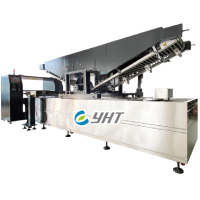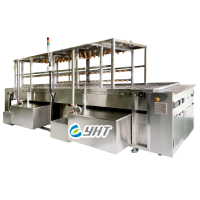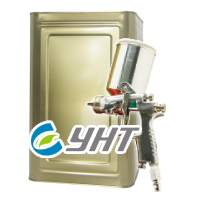FAQ
Water transfer printing is a decorative printing process in which a film is applied to a surface using water. The film is printed with a design, and when it is immersed in water, the film dissolves, the ink floats to the surface and adheres to the object being decorated.
All film comes in rolls, size include:
Width 50 cm X Length 600 meters
Width 60 cm X Length 500 meters
Width 100cm X Length 250 meters
Sometimes we have small stock film, please contact us for details.
Water transfer printing is a process that can be used to decorate and customize a variety of objects, but it is important to note that additional steps must be taken to ensure durability.
The standard process for water transfer printing includes cleaning the object, applying a primer, drying, cooling, water transfer, washing, drying, applying a topcoat, drying, and cooling again. This process helps to make the surface firm and durable. Some special requirements of the base coat and topcoats may be necessary for objects that will be used in aviation, automotive, or hunting industries.
Firmness and durability must be affected by the different weather in each country, and the topcoat will also affect the life of the object.
Water transfer printing can be done by hand for simple projects or by using a professional production line for larger quantities. For small scale projects, a tank and film with activator may be sufficient. However, for more stable and efficient production, a complete water transfer printing production line is necessary.
This typically includes a spray booth, oven, water transfer printing tank, and washing machine. The size of the machines will depend on the customer's quantity and quality requirements. For more information on the machines and spare parts, you can visit the provided link - Hydro Dipping Equipment and Automatic Water Transfer Printing Equipment.
Additionally, there are videos available that demonstrates the water transfer printing process.
The cost of water transfer printing will depend on a variety of factors, including the size and complexity of the design, the material being decorated, the quantity of items being decorated, and the method and equipment being used. In general, water transfer printing can be a more affordable option compared to other customization techniques. However, this all depends on your project's specific details. It is best to consult with a company or service that offers water transfer printing for an accurate estimate for your specific project.
Water transfer printing is also known by several other names, including cubic printing, hydrographics, hydro printing, hydro dipping, and immersion printing. These terms all refer to the same process of transferring a design onto an object using water and a film containing the design.
Despite the different names, the basic process is the same and involves immersing the object in water, applying the film with the design, and then allowing the design to transfer onto the object as the film dissolves.
The objects should be dried completely before doing dipping.
You should use a base coat color that matches the desired film pattern.
If you use too little activator on the film during the dipping process, there may be air bubbles on the surface of the item after the transfer printing.
If you use too much activator on the film during the dipping process, the film ink (patterns) may slip off the item.
Water transfer printing can be applied to a variety of smooth, non-porous surfaces, such as guns, automotive parts, appliances, and sporting goods. If you are unsure if your project or material is suitable for water transfer printing, you can find more information on this topic in the blog titled "Materials for Hydro Dipping : What Can and What Cannot?"
YHT offers a wide range of custom-designed water transfer printing films to choose from, with over 1000 options available. If you're not sure which film would be best for your project, our team is happy to assist you in selecting the right one based on your specific needs.
Yes, we offer customization options that allow you to create a unique and custom water transfer printing film design. If you're interested in learning more about our customization services, please don't hesitate to contact us.
You can purchase our films directly from us. We offer global shipping, so regardless of your location, you can enjoy the benefits of our high-quality films.
Proper pretreatment before hydro dipping is essential for a successful outcome. The process includes inspecting the product's surface for visible impurities and using sandpaper to polish it if it's necesary, testing the smoothness of the surface and eliminating roughness, searching for and removing contaminants such as oil stains and dust, and using a pattern remover or sandpaper to eliminate defects. It's also important to keep the product clean and dry after pretreatment and store it in a clean and dry place before continuing to the next step in the process. Failure to properly pretreat the product can result in hydrographic failures.
When it comes to hydrographics film, there are two sides: a glossy side and a matte side. You need to know which side is which so that you can be sure to use the correct side during the hydro dipping process.
There are a number of factors that can impact the quality of water transfer printing films, including the thickness and durability of the film, its accuracy and clarity, and how it performs during the printing process. Higher quality films tend to be made of thicker, more durable materials with more precise designs and vibrant colors, leading to fewer defects and a higher overall yield. It's important to consider the quality of the film when choosing a product for a specific project, as using a lower quality film can result in poor results and potentially costly defects. In cases where the project requires a high level of detail or the film will be subjected to harsh conditions or heavy use, it is worth investing in a higher quality film.
One of the most important things when selecting the film, make sure the film's size fits the product surface. For example, if the hydrographic film width that you choose is only 60cm, but your product is 80cm x 80cm, this film is not suitable for your product, since it is too small to cover the surface.
There are many types of water transfer printing films on the market, and the popularity of specific films can vary depending on the region, industry, and individual preferences of the users. Some of the most common types of water transfer printing films include Camouflage Hydrographic Film, Carbon Fiber Hydro Dip Films, Metal Brushed Hydrographic Film, Wood Grain Hydrographic Film, etc.











